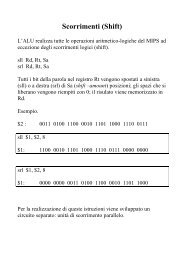Dispensa in PDF - Dipartimento di Scienze Ambientali, Informatica e ...
Dispensa in PDF - Dipartimento di Scienze Ambientali, Informatica e ...
Dispensa in PDF - Dipartimento di Scienze Ambientali, Informatica e ...
Create successful ePaper yourself
Turn your PDF publications into a flip-book with our unique Google optimized e-Paper software.
Macch<strong>in</strong>a 1 Macch<strong>in</strong>a 2<br />
browser richiesta Web<br />
server<br />
Carnielli Efrem: Programmazione a componenti<br />
richiesta<br />
responso responso<br />
Figura 1.4. Interazione tra processi <strong>in</strong> ambiente s<strong>in</strong>gle-thread<br />
Programmazione a componenti<br />
DB server<br />
Il problema è chiaro, il web server non può rispondere al browser f<strong>in</strong>chè il DB<br />
server non risponde.<br />
Ma cosa avviene esattamente? Ve<strong>di</strong>amo <strong>in</strong> figura 1.5 una rappresentazione degli<br />
stati dei processi.<br />
Il processo relativo al web server è nello stato <strong>di</strong> runn<strong>in</strong>g, una volta che <strong>in</strong>oltra la<br />
richiesta al DB server deve attendere che quest’ultimo risponda, lo scheduler si<br />
preoccupa <strong>di</strong> metterlo <strong>in</strong> wait e per fare ciò è necessario salvare <strong>in</strong> memoria<br />
centrale lo stato <strong>di</strong> esecuzione del processo che viene bloccato. Queste <strong>in</strong>formazioni<br />
vengono memorizzate proprio nel PCB del processo, e sarà sempre dal PCB che<br />
esse verranno lette quando si dovrà proseguire l'esecuzione; la risorsa processore<br />
viene liberata e sempre lo scheduler si preoccupa <strong>di</strong> assegnarla al DB server che<br />
deve rispondere. Avviene qu<strong>in</strong><strong>di</strong> un contest switch che si ripete non appena il DB<br />
server avrà confezionato ed <strong>in</strong>viato la risposta al web server.<br />
Supponiamo qu<strong>in</strong><strong>di</strong> che il web server sia il processo che si mette <strong>in</strong> wait<strong>in</strong>g dopo<br />
ogni richiesta del browser per aspettare l’evento “responso del web server”; se<br />
arrivassero 1000 avrei una commutazione <strong>di</strong> contesto cont<strong>in</strong>ua solo per risolvere<br />
richieste magari esigue.<br />
Il proce<strong>di</strong>mento è notevolmente costoso.<br />
11
















